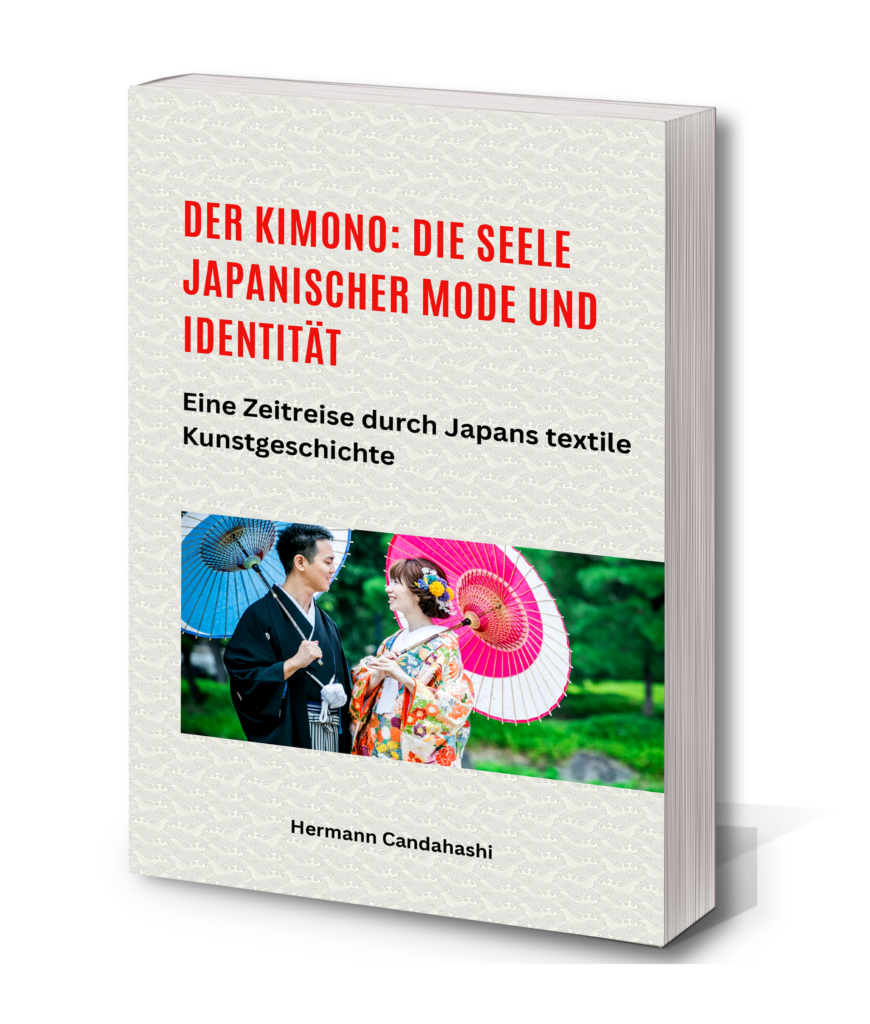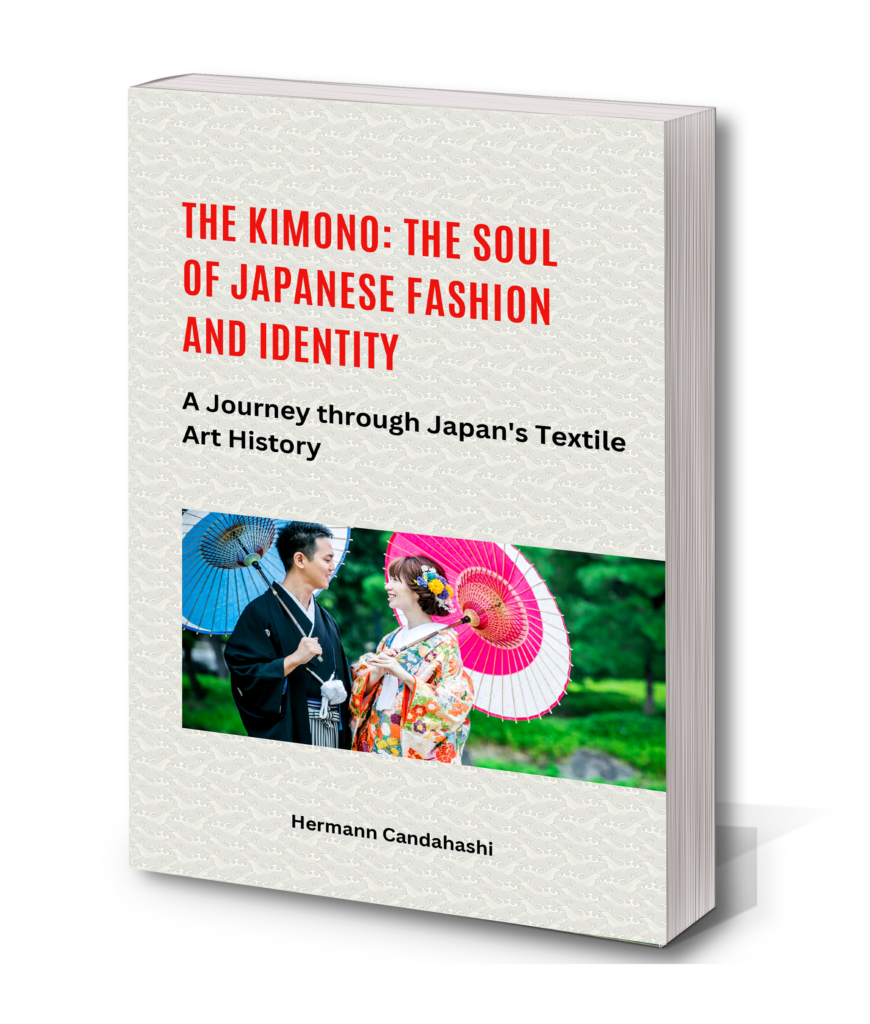

why this book:
The Kimono, a garment that reflects the culture of Japan like no other, is much more than a piece of fabric. It is a living connection between the past and the present, between tradition and individual expression. This book is dedicated to the fascinating world of the Kimono and takes you on a journey through the history, symbolism and meaning of this iconic garment.
From the fine fabrics worn in the imperial palaces of ancient Japan to the modern interpretations that can be seen on the catwalks and streets around the world today, the Kimono tells stories that go far beyond its visible beauty. It is not just fashion, but a mirror of Japanese identity, a canvas for art and a medium that connects generations.
The book that lies before you is the result of an intensive examination of the culture and history of Japan, but also of the universal question of how clothing shapes us as individuals and as a society. The approach of this book is deliberately interdisciplinary: historical facts and social analyses are interwoven with personal observations and insights to create a lively and holistic picture.
My aim was to make the magic of the Kimono tangible – both for those who already love Japan and for readers who are embarking on this cultural adventure for the first time. The Kimono is a key that opens doors to a deeper understanding: of aesthetics and craftsmanship, of social codes and rituals, of the development of a nation and its people.
This book is not a dry treatise, but an attempt to take you on a journey of discovery in which knowledge is combined with emotions. The stories and examples you will find here have been carefully selected to illuminate the many facets of the Kimono. Some will amaze you, others may make you think. And perhaps the Kimono will become more than just a graceful and magical garment for you too – an invitation to discover the beauty and depth of a culture that is characterized by its uniqueness.
I invite you to read these lines. Let yourself be inspired by the elegance and symbolism of the Kimono and discover what this garment has to say about Japan and the people who wear it. It is a story of art and craft, of innovation and tradition, of individual expressiveness and collective identity.
I hope you enjoy reading and discoveringYours, Hermann Candahashi
An excerpt:
The Kimono is much more than just a garment; it is a symbol of Japan and its unique cultural identity. With its sumptuous fabrics, detailed patterns and profound symbolism, the Kimono is a window into Japanese history, art and society. But how did this garment come about and what makes it so significant?
The journey through the world of the Kimono takes us through centuries of Japanese cultural history. From the courtyard of the Imperial Palace in the Heian period to the streets of the Edo era to the catwalks of today’s fashion world – the Kimono tells stories of tradition, change and permanence.
Whether you are a lover of Japanese culture, a fashion enthusiast or simply a curious reader, this book offers a comprehensive and fascinating look at the Kimono. Let us delve into the world of this iconic garment together and discover the secrets it holds.
A symbol of timeless elegance and cultural depth, the Kimono has not only shaped Japanese fashion over the centuries, but has also sparked fascination far beyond its geographical borders. This garment, whose name simply translates to “thing to wear,” carries a complexity and meaning that tells a story with every fold, fabric pattern, and shade of color.
The Kimono’s roots reach deep into Japanese history, yet its symbolism is by no means limited to Japan. It is a window into a world where clothing not only has function, but also expresses identity, status, and spirituality. The first glimpse of a Kimono begins a journey that takes us from the ancient imperial courts to the bustling streets of modern cities where this clothing is still a symbol of tradition and pride.
But to truly understand the world of Kimono, we must go beyond the surface. Every detail, from the choice of fabric to the way it is tied, has meaning. This journey is a discovery of craftsmanship, history, and the art of storytelling through textiles. It is a cultural artifact that both reflects changing times and embodies the eternity of an unchanging ideal. It is a piece of history that is worn – a living testimony to the connection between past and present.
The origins of the Kimono can be traced back to the Heian period (794-1185), a period known for its cultural flowering and development of aesthetic ideals. It was during this period that the clothing we know today as Kimono began to take shape. Cuts became simpler, fabrics finer, and the art of wearing it developed into a symbolic form of expression. The Kimono was more than just practical clothing. It was a reflection of social status, the seasons, and even personal emotions.
The structure of a Kimono may seem simple at first glance: a T-shaped cut, long sleeves, and a straight collar. But in this simplicity lies a remarkable complexity. The Kimono is not sewn to fit the body. Instead, it is the way it is folded, draped, and tied that gives it its distinctive shape. It is as if the fabric itself plays the main role, while the wearer becomes a transformable canvas for artistic design.
The variety of shapes and purposes of Kimonos is remarkable and reflects the complexity of Japanese culture. Each type of Kimono is associated with a specific occasion, a certain social status or a stage of life. This differentiation is not only evident in the cuts and patterns, but also in the way the Kimonos are worn.
One of the most well-known variations is the furisode, a Kimono with particularly long sleeves. This form is traditionally worn by unmarried women and is considered a symbol of youth and elegance. The furisode is often decorated with bright colors and elaborate patterns to emphasize the vitality and liveliness of the wearer.
The tomesode, on the other hand, is the choice of married women. It is characterized by shorter sleeves and subtle patterns that are often only found on the lower part of the Kimono. The tomesode is worn primarily on formal occasions such as weddings or official receptions and conveys dignity and restraint.
There are also specific versions of the Kimono for men. The montsuki is a formal black Kimono decorated with a family crest and is often combined with hakama pants. This combination is common for special occasions such as weddings or funerals.
The yukata, a lighter and more straightforward form of Kimono, is worn mainly in summer and on relaxed occasions. Made from cotton and without additional lining, the yukata offers an airy alternative to the more formal versions. It is particularly popular at summer festivals, where the vibrant patterns and bright colors add a special atmosphere to the festivities. The yukata is also often used as casual wear in traditional onsen (hot springs).
In addition, there are Kimonos that are specially designed for certain ceremonies or cultural activities. One example is the iro muji, a plain Kimono that is often worn during tea ceremonies. Its simplicity draws attention to the wearer’s posture and movements, which is in keeping with the philosophy of the tea ceremony.
Dancers of traditional Japanese dance or actors of the kabuki theater often wear Kimonos that are specially made for their performances. These Kimonos are usually richly decorated and designed for dramatic movements to maximize the visual impact on stage.
Today’s fashion has reinterpreted the Kimono in creative ways. There are hybrid designs that incorporate elements of Western clothing, as well as modern Kimonos suitable for everyday wear. These are often made from easy-care materials and have a simplified structure that makes them easier to put on, while still retaining the basic features of the traditional Kimono.
Interestingly, the Kimono has also found a role in areas such as hospitality or tourism. Many employees in ryokan (traditional inns) or upscale Japanese restaurants wear Kimonos that have been specially adapted for everyday professional wear. These work Kimonos are practical, durable, yet aesthetically pleasing.
The various shapes and purposes of the Kimono reflect the values of Japanese society: respect for traditions, the ability to adapt, and a deep appreciation for aesthetics. Each Kimono tells a story not only about the wearer, but also about the time, place, and cultural circumstances that shaped it. This diversity makes the Kimono much more than just a piece of clothing – it is a living language that expresses identity, status, and emotions.
The symbolism on Kimonos plays a central role in their design and conveys messages that are deeply rooted in Japanese culture. Patterns, colors and motifs are carefully chosen to reflect seasons, desires, social status or spiritual beliefs. These details make the Kimono a living canvas that tells stories.
In the world of Kimono, colors, patterns, and even the way it is tied speak their own language. An unmarried girl wears a “furisode,” a Kimono with particularly long, flowing sleeves that express joie de vivre and youthful lightheartedness. A married woman, on the other hand, opts for a simpler “tomesode,” whose understated design emphasizes her maturity and dignity.
The type of obi, the wide fabric belt that holds the Kimono together, is also important. The obi can be tied in countless styles, each with its own symbolic meaning. A young girl’s elaborate bow may be playful and elaborate, while an older woman prefers a simpler, more elegant tie.
